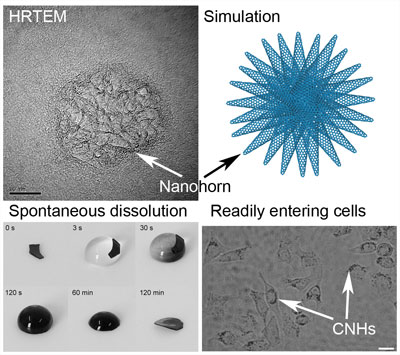| Posted: May 01, 2007 | |
Carbon nanohorns as potential intracellular delivery vehicle |
|
| (Nanowerk Spotlight) Currently, the most common carrier vehicles to deliver therapeutic drugs, genes or proteins to a patient's target cells are viruses that have been genetically altered to carry the desired payload. These viruses infect cells, deposit their payloads, and take over the cells' machinery to produce the desirable proteins. One problem with this method is that the human body has developed a very effective immune system that protects it from viral infections and another problem is that viral-based delivery vehicles may integrate into the host genome. Thanks to advances in nanotechnology fabrication techniques, the development of nonviral nanocarriers for gene and drug delivery has become possible. Besides viruses, polymeric systems and various inorganic nanomaterials are under intensive investigation as nonviral delivery vehicles. Finding new candidates for vehicles is still of great interest because most existing synthetic vehicles exhibit intrinsic cytotoxicity and show relatively low delivery efficiency. Enter the carbon nanohorn (CNH). This recently recognized member of the fullerene family has a unique dahlia flower-like structure, huge surface areas and can be fabricated with high purity. Researchers believe that CNHs may have potential advantages over normal nanoparticles, nanorods and nanotubes as synthetic intracellular delivery vehicles. | |
| "A single CNH has a structure similar to a pudgy single-walled carbon nanotube with one end closed in a cone-shaped cap (horn)" Dr. Fengbao Zhang explains to Nanowerk. "Due to strong van der Waals forces, they form unique nanoscale spherical dahlia-like assemblies with a large number of horn-shaped, short, single-layered nanotubes that stick out in all directions. These structures show great potential in biological applications. But this potential is hindered by their insolubility in water and their strong tendency to agglomerate to micronsize structures. In our recent work we prove both experimentally and theoretically that spherical CNHs could be isolated through steric stabilization by a copolymer (Gum Arabic)." | |
| Another part of Zhang's research was to evaluate preliminarily the potential of these isolated CNHs as synthetic vehicles for intracellular delivery. | |
| Zhang is professor at the College of Chemical Engineering & Technology at Tianjin University in PR China. Together with his colleagues he published a paper on these CNH assemblies in a recent issue of Nanotechnology ("Isolation of carbon nanohorn assemblies and their potential for intracellular delivery"). | |
 |
|
| (upper left) Typical HRTEM image of CNHs after modification. The scale bar is 10 nm. (upper right) Simulation of a carbon nanohorn structure. (lower left) Illustration of the spontaneous dissolution of modified CNHs. (lower right) Light microscopy image of HeLa cells after incubation with modified CNHs. The black spots in show the perinuclear accumulation of CNHs. The scale bar is 20 µm. (Images: Dr. Zhang) | |
| CNHs were discovered in 1998 by Dr. Sumio Iijima's research group. These particles have the same graphitic carbon atom structure as normal carbon nanotubes. Unlike carbon nanotubes, carbon nanohorns can be made simply without the use of a catalyst. | |
| Compared with common nanoparticles, CNHs key characteristic is high adsorbability to hold therapeutic drugs, genes or proteins due to their large surface area – about 400 square meters per gram – and large number of cavities. Notably, the modified CNHs can spontaneously dissolve in water. | |
| "We were excited to find that they are nontoxic and could readily enter human cervical cancer cells, which means that they may be used as a new, nontoxic synthetic gene delivery vehicle for gene therapy" says Zhang. | |
| Studies of the cytotoxicity of CNHs were performed by incubating modified CNHs with human cervical cancer cells for 8 hours. Cell viability analysis (MTT assay) after 24 h showed that more than 80% of the cells remained viable even with CNHs? concentrations up to 1 mg ml-1, and no obvious decrease of the cell viability was observed with time getting longer (48 and 72 hours later). | |
| "This result means the modified CNHs are nontoxic" says Zhang. "High purity CNHs can be prepared without the use of metallic catalysts which accounts for most the cytotoxicity of carbon nanotubes. Thus CNHs have superior biocompatibility. Besides, the surface modification of CNHs with natural polysaccharide may also improve the biocompatibility." | |
| Zhang's work introduces an easy and effective method to obtain isolated hydrophilic CNH assemblies. This method could be readily applied to various copolymers, in order to obtain isolated hydrophilic CNHs with different properties for biological application, especially as intracellular delivery vehicles for gene therapy. | |
| Building on their initial findings, the Chinese researchers are now investigating the interaction between CNHs and some therapeutic genes and proteins, which is necessary to explore the application of CNHs as gene delivery vehicles. They also intend to study the long-term cytotoxicity, both in vitro and in vivo and fate of CNHs in biological systems. | |
 By
Michael
Berger
– Michael is author of three books by the Royal Society of Chemistry:
Nano-Society: Pushing the Boundaries of Technology,
Nanotechnology: The Future is Tiny, and
Nanoengineering: The Skills and Tools Making Technology Invisible
Copyright ©
Nanowerk LLC
By
Michael
Berger
– Michael is author of three books by the Royal Society of Chemistry:
Nano-Society: Pushing the Boundaries of Technology,
Nanotechnology: The Future is Tiny, and
Nanoengineering: The Skills and Tools Making Technology Invisible
Copyright ©
Nanowerk LLC
|
Become a Spotlight guest author! Join our large and growing group of guest contributors. Have you just published a scientific paper or have other exciting developments to share with the nanotechnology community? Here is how to publish on nanowerk.com.
